Analog Devices QFX402, OCP803, OFX803, OFD803 User Manual
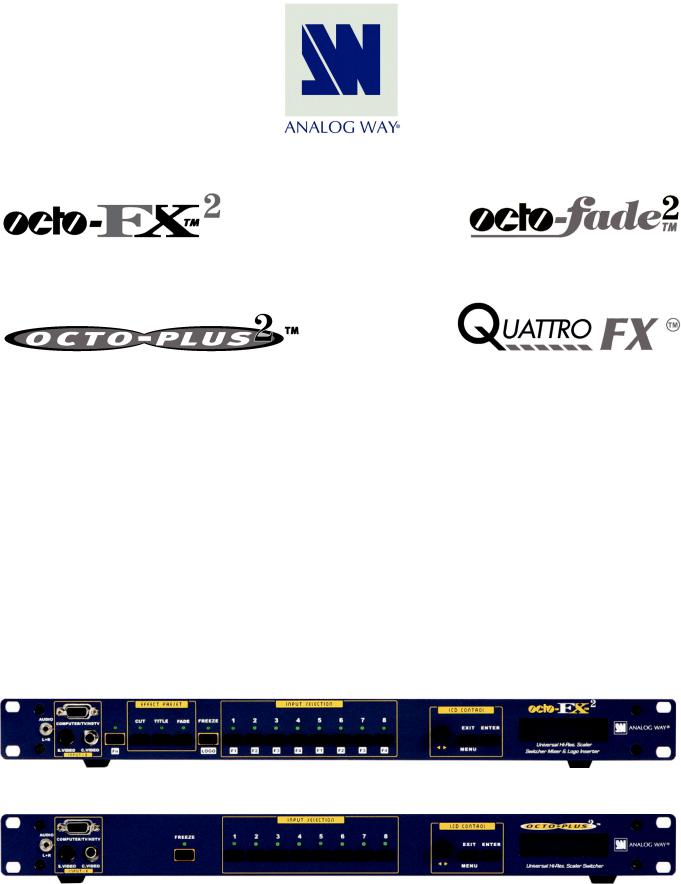
MODEL: OFX803 |
MODEL: OFD803 |
MODEL: OCP803 |
MODEL: QFX402 |
User’s Manual
ANALOG WAY® |
OCTO² / QFX402 |
EDITION : 11 / 06 |
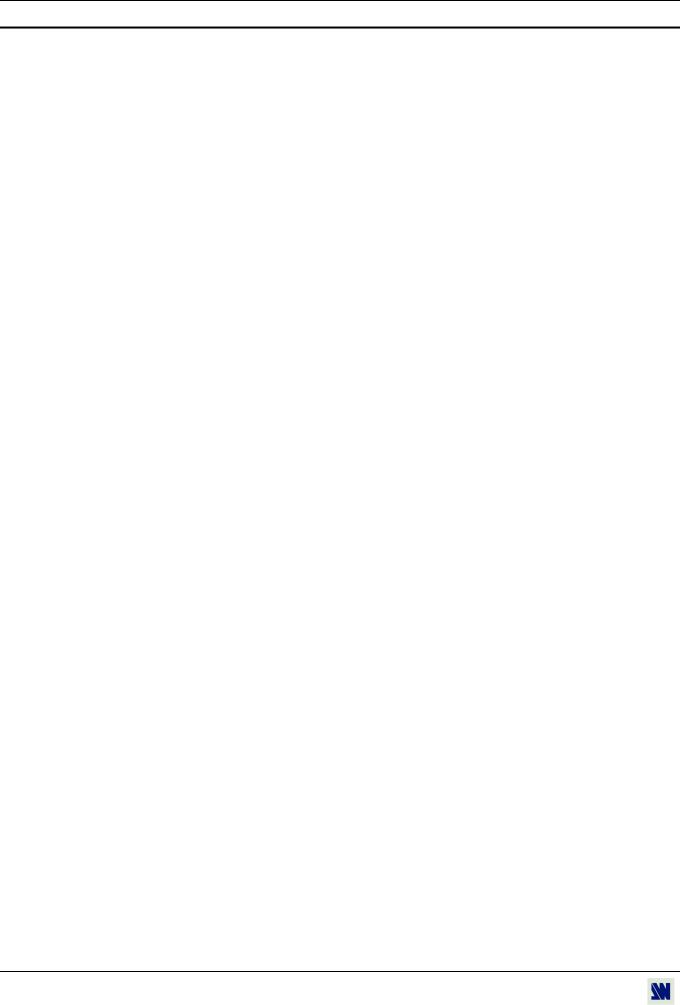
|
OCTO² / QFX402 |
TABLE OF CONTENTS |
|
SAFETY INSTRUCTIONS........................................................................................................................................................... |
3 |
QUICK START GUIDE - OCTO2................................................................................................................................................. |
6 |
QUICK START GUIDE - QUATTRO FX.................................................................................................................................... |
7 |
Chapter 1 : INTRODUCTION ....................................................................................................................................................... |
8 |
1-1. ACCESSORIES SUPPLIED .............................................................................................................................................. |
8 |
1-2. OCTO² GENERAL INFORMATION ................................................................................................................................ |
8 |
1-3. QUATTRO FX GENERAL INFORMATION ................................................................................................................... |
9 |
1-4. DEVICES & OPTIONS REFERENCES............................................................................................................................ |
9 |
1-5. INSTALLATION................................................................................................................................................................ |
9 |
1-6. OCTO² FRONT PANEL DESCRIPTION........................................................................................................................ |
10 |
1-7. QUATTRO-FX FRONT PANEL DESCRIPTION .......................................................................................................... |
11 |
1-8. OCTO² REAR PANEL DESCRIPTION .......................................................................................................................... |
12 |
1-9. QUATTRO FX REAR PANEL DESCRIPTION ............................................................................................................. |
13 |
Chapter 2 : STARTING ............................................................................................................................................................... |
14 |
2-1. OCTO² CONNECTIONS ................................................................................................................................................. |
14 |
2-2. QUATTRO FX CONNECTIONS .................................................................................................................................... |
14 |
2-3. INPUT #1 DESCRIPTION............................................................................................................................................... |
15 |
2-4. INPUTS #2 to 8 DESCRIPTION...................................................................................................................................... |
16 |
2-5. OUTPUTS DESCRIPTION.............................................................................................................................................. |
16 |
2-6. AUDIO INPUTS............................................................................................................................................................... |
17 |
2-7. AUDIO OUTPUT............................................................................................................................................................. |
18 |
Chapter 3 : OPERATING MODE................................................................................................................................................ |
19 |
3-1. SETTINGS........................................................................................................................................................................ |
19 |
3-2. SWITCHING OPERATIONS .......................................................................................................................................... |
20 |
3-3. DISPLAY DEVICE ADJUSTMENTS............................................................................................................................. |
21 |
3-4. IMAGE ADJUSTMENTS ................................................................................................................................................ |
21 |
3-5. AUDIO ADJUSTMENTS ................................................................................................................................................ |
21 |
Chapter 4 : USING FRAME STORE AND LOGO INSERTION ............................................................................................... |
22 |
4-1. LOGO INSERTION ......................................................................................................................................................... |
22 |
4-2. USING THE FRAME STORE ......................................................................................................................................... |
23 |
Chapter 5 : FRONT PANEL DISPLAY MENUS DESCRIPTION............................................................................................. |
24 |
5-1. INTRODUCTION ............................................................................................................................................................ |
24 |
5-2. CONTROL BUTTONS .................................................................................................................................................... |
24 |
5-3. STATUS MODE............................................................................................................................................................... |
24 |
5-4. CONTROL MODE........................................................................................................................................................... |
25 |
5-5. FUNCTIONS DESCRIPTION ......................................................................................................................................... |
27 |
Chapter 6 : UPDATING THE DEVICE ...................................................................................................................................... |
37 |
6-1. CONNECTIONS .............................................................................................................................................................. |
37 |
6-2. UPDATE INSTRUCTIONS ............................................................................................................................................. |
37 |
Chapter 7 : REMOTE CONTROL SOFTWARE......................................................................................................................... |
38 |
7-1. CONNECTIONS .............................................................................................................................................................. |
38 |
7-2. SOFTWARE INSTALLATION: ...................................................................................................................................... |
38 |
7-3. COMMUNICATION SETUP........................................................................................................................................... |
38 |
7-4. USING THE SOFTWARE ............................................................................................................................................... |
39 |
Chapter 8 : TECHNICAL SPECIFICATIONS............................................................................................................................ |
41 |
8-1. COMPUTER & VIDEO INPUTS .................................................................................................................................... |
41 |
8-2. DISPLAY OUTPUTS....................................................................................................................................................... |
42 |
8-3. AUDIO INPUTS............................................................................................................................................................... |
42 |
8-4. AUDIO OUTPUT............................................................................................................................................................. |
43 |
8-5. COMMUNICATION PORTS .......................................................................................................................................... |
43 |
8-6. TRIGGER ......................................................................................................................................................................... |
43 |
8-7. ENVIRONMENTAL........................................................................................................................................................ |
43 |
APPENDIX A: PROGRAMMER'S GUIDE................................................................................................................................ |
44 |
A-1: INTRODUCTION ........................................................................................................................................................... |
44 |
A-2: COMMANDS STRUCTURE.......................................................................................................................................... |
44 |
A-3: ERROR RESPONSES ..................................................................................................................................................... |
44 |
A-4: COMMANDS AND RESPONSES TABLE.................................................................................................................... |
45 |
A-5: ASCII / HEX / DEC TABLE........................................................................................................................................... |
51 |
WARRANTY............................................................................................................................................................................... |
52 |
PAGE 2
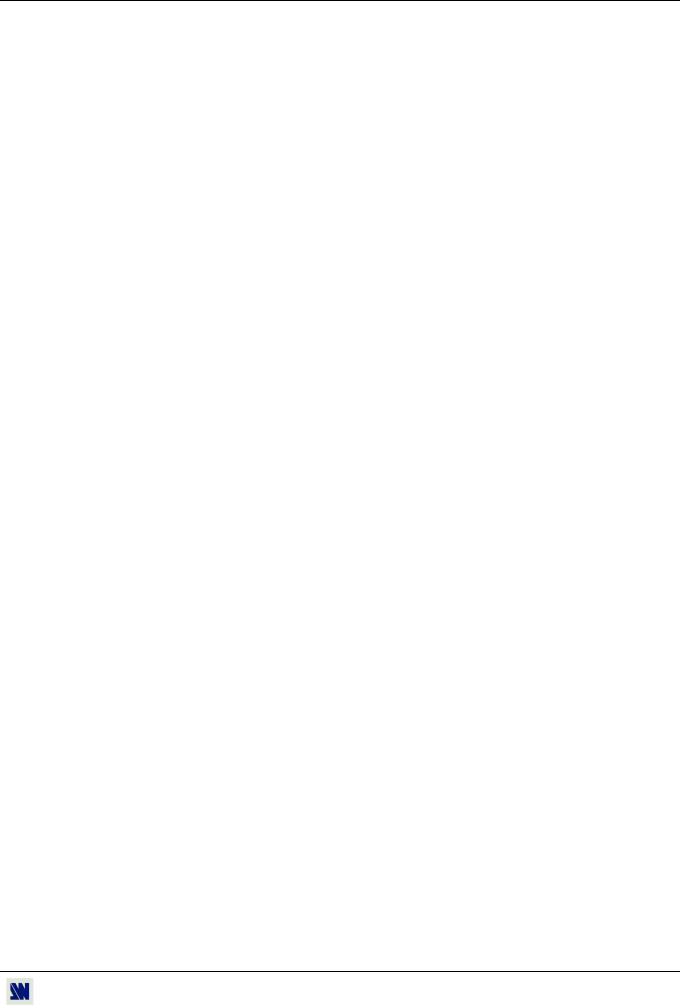
OCTO² / QFX402
SAFETY INSTRUCTIONS
All of the safety and operating instructions should be read before the product is operated and should be retained for further reference. Please follow all of the warnings on this product and its operating instructions.
CAUTION: |
|
WARNING: |
To prevent the risk of electric shock and fire, do not expose this device to rain, humidity or intense |
|
heat sources (such as heaters or direct sunlight). Slots and openings in the device are provided for |
|
ventilation and to avoid overheating. Make sure the device is never placed on or near a textile |
|
surface that could block the openings. Also keep away from excessive dust, vibrations and shocks. |
POWER: |
Only use the power supply indicated on the device or on the power source. Devices equipped with a |
|
grounding plug should only be used with a grounding type outlet. In no way should this grounding |
|
be modified, avoided or suppressed. |
POWER CORD: Use the On (I) / Off (O) switch to power On or Off devices equipped with that switch. All other devices should be plugged and unplugged from wall outlet. In both cases, please follow these instructions:
-The power cord of the device should be unplugged from the outlet when left unused for several days.
-To unplug the device, do not pull on the power cord but always on the plug itself.
-The outlet should always be near the device and easily accessible.
-Power supply cords should be routed so that they are not likely to be walked on or pinched by items placed upon or against them.
If the power supply cord is damaged, unplug the device. Using the device with a damaged power supply cord may expose you to electric shocks or other hazards. Verify the condition of the power supply cords once in a while. Contact your dealer or service center for replacement if damaged.
CONNECTIONS: All inputs and outputs (except for the power input) are TBTS defined under EN60950.
SERVICING: |
Do not attempt to service this product yourself by opening or removing covers and screws since it |
|
may expose you to electric shocks or other hazards. Refer all problems to qualified service |
|
personnel. |
OPENINGS: |
Never push objects of any kind into this product through the openings. If liquids have been spilled or |
|
objects have fallen into the device, unplug it immediately and have it checked by a qualified |
|
technician. |
PAGE 3
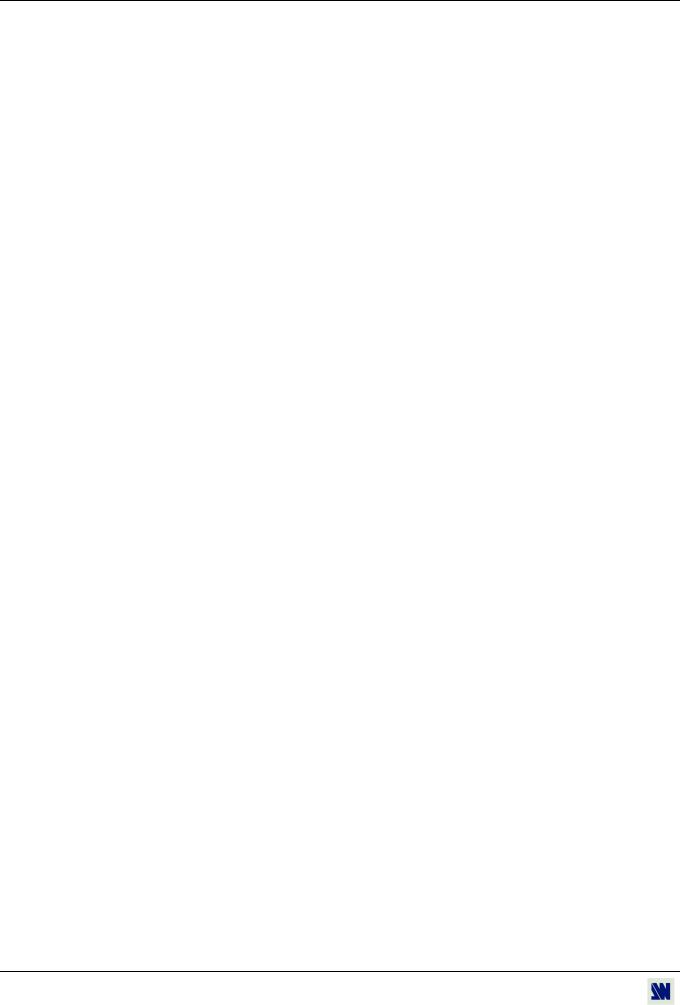
OCTO² / QFX402
INSTRUCTIONS DE SÉCURITÉ
Afin de mieux comprendre le fonctionnement de cet appareil nous vous conseillons de bien lire toutes les consignes de sécurité et de fonctionnement de l’appareil avant utilisation. Conserver les instructions de sécurité et de fonctionnement afin de pouvoir les consulter ultérieurement. Respecter toutes les consignes marquées dans la documentation, sur le produit et sur ce document.
ATTENTION : Afin de prévenir tout risque de choc électrique et d’incendie, ne pas exposer cet appareil à la pluie, à l’humidité et aux sources de chaleur intense.
INSTALLATION : Veillez à assurer une circulation d’air suffisante pour éviter toute surchauffe à l’intérieur de l’appareil. Ne placez pas l’appareil sur ou proximité de surface textile susceptible d’obstruer les orifices de ventilation. N’installez pas l’appareil à proximité de sources de chaleur comme un radiateur ou une bouche d’air chaud, ni dans un endroit exposé au rayonnement solaire direct, à des poussières excessives, à des vibrations ou à des chocs mécaniques. Ceci pourrait provoquer un mauvais fonctionnement et un accident.
ALIMENTATION : Ne faire fonctionner l’appareil qu’avec la source d’alimentation indiquée sur l’appareil ou sur son bloc alimentation. Pour les appareils équipés d’une alimentation principale avec fil de terre, ils doivent être obligatoirement connectés sur une source équipée d’une mise à la terre efficace. En aucun cas cette liaison de terre ne devra être modifiée, contournée ou supprimée.
CORDON D’ALIMENTATION : Pour les appareils équipés d’un interrupteur général (Marche I / Arrêt O), la mise sous tension et la mise hors tension se fait en actionnant cet interrupteur général. Pour les appareils sans interrupteur général, la mise sous tension et la mise hors tension se fait directement en connectant et déconnectant le cordon d'alimentation de la prise murale.
Dans les 2 cas ci-dessus appliquer les consignes suivantes :
-Débrancher le cordon d'alimentation de la prise murale si vous prévoyez de ne pas utiliser l'appareil pendant quelques jours ou plus.
-Pour débrancher le cordon, tirez le par la fiche. Ne tirez jamais sur le cordon proprement dit.
-La prise d’alimentation doit se trouver à proximité de l’appareil et être aisément accessible.
-Ne laissez pas tomber le cordon d’alimentation et ne posez pas d’objets lourds dessus.
Si le cordon d’alimentation est endommagé, débranchez le immédiatement de la prise murale. Il est dangereux de faire fonctionner cet appareil avec un cordon endommagé, un câble abîmé peut provoquer un risque d’incendie ou un choc électrique. Vérifier le câble d’alimentation de temps en temps. Contacter votre revendeur ou le service après vente pour un remplacement.
CONNEXIONS : Toutes les entrées et sorties (exceptée l’entrée secteur) sont de type TBTS (Très Basse Tension de Sécurité) définies selon EN 60950.
RÉPARATION ET MAINTENANCE : L’utilisateur ne doit en aucun cas essayer de procéder aux opérations de dépannage, car l’ouverture des appareils par retrait des capots ou de toutes autres pièces constituant les boîtiers ainsi que le dévissage des vis apparentes à l’extérieur, risque d’exposer l’utilisateur à des chocs électriques ou autres dangers. Contacter le service après vente ou votre revendeur ou s’adresser à un personnel qualifié uniquement.
OUVERTURES ET ORIFICES : Les appareils peuvent comporter des ouvertures (aération, fentes, etc...), veuillez ne jamais y introduire d’objets et ne jamais obstruer ses ouvertures. Si un liquide ou un objet pénètre à l’intérieur de l’appareil, débranchez immédiatement l’appareil et faites le contrôler par un personnel qualifié avant de le remettre en service.
ISTRUZIONI DI SICUREZZA
Allo scopo di capire meglio il funzionamento di questa apparecchiatura vi consigliamo di leggere bene tutti i consigli di sicurezza e di funzionamento prima dell’utilizzo. Conservare le istruzioni di sicurezza e di funzionamento al fine di poterle consultare ulteriormente. Seguire tutti i consigli indicati su questo manuale e sull’apparecchiatura.
ATTENZIONE : Al fine di prevenire qualsiasi rischio di shock elettrico e d’incendio, non esporre l’apparecchiatura a pioggia, umidità e a sorgenti di eccessivo calore.
INSTALLAZIONE : Assicuratevi che vi sia una sufficiente circolazione d’aria per evitare qualsiasi surriscaldamento all’interno dell’apparecchiatura. Non collocare l’apparecchiatura in prossimità o su superfici tessili suscettibili di ostruire il funzionamento della ventilazione. Non installate l’apparecchiatura in prossimità di sorgenti di calore come un radiatore o una fuoruscita d’aria calda, né in un posto esposto direttamente ai raggi del sole, a polvere eccessiva, a vibrazioni o a shock meccanici. Ció potrebbe provocare un erroneo funzionamento e un incidente.
ALIMENTAZIONE : Far funzionare l’apparecchiatura solo con la sorgente d’alimentazione indicata sull’apparecchiatura o sul suo alimentatore. Per le apparecchiature fornite di un’alimentazione principale con cavo di terra, queste devono essere obbligatoriamente collegate su una sorgente fornita di una efficiente messa a terra. In nessun caso questo collegamento potrà essere modificato, sostituito o eliminato.
CAVO DI ALIMENTAZIONE : Per le apparecchiature fornite di interruttore generale (Acceso I / Spento O), l’accensione e lo spegnimento dell’apparecchiatura si effettuano attraverso l’interruttore. Per le apparecchiature senza interruttore generale, l’accensione e lo spegnimento si effettuano direttamente inserendo o disinserendo la spina del cavo nella presa murale.
In entrambe i casi applicare i seguenti consigli :
-Disconnettere l’apparecchiatura dalla presa murale se si prevede di non utilizzarla per qualche giorno.
-Per disconnettere il cavo tirare facendo forza sul connettore.
-La presa d’alimentazione deve trovarsi in prossimità dell’apparecchiatura ed essere facilmente accessibile.
-Non far cadere il cavo di alimentazione né appoggiarci sopra degli oggetti pesanti.
Se il cavo di alimentazione é danneggiato, spegnere immediatamente l’apparecchiatura. E’ pericoloso far funzionare questa apparecchiatura con un cavo di alimentazione danneggiato, un cavo graffiato puó provocare un rischio di incendio o uno shock elettrico. Verificare il cavo di alimentazione spesso. Contattare il vostro rivenditore o il servizio assistenza per una sostituzione.
CONNESSIONE : Tutti gli ingressi e le uscite (eccetto l’alimentazione) sono di tipo TBTS definite secondo EN 60950.
RIPARAZIONI E ASSISTENZA : L’utilizzatore non deve in nessun caso cercare di riparare l’apparecchiatura, poiché con l’apertura del coperchio metallico o di qualsiasi altro pezzo costituente la scatola metallica, nonché svitare le viti che appaiono esteriormente, poiché ció puó provocare all’utilizzatore un rischio di shock elettrico o altri rischi.
APERTURE DI VENTILAZIONE : Le apparecchiature possono comportare delle aperture di ventilazione, si prega di non introdurre mai oggetti o ostruire le sue fessure. Se un liquido o un oggetto penetra all’interno dell’apparecchiatura, disconnetterla e farla controllare da personale qualificato prima di rimetterla in servizio.
PAGE 4
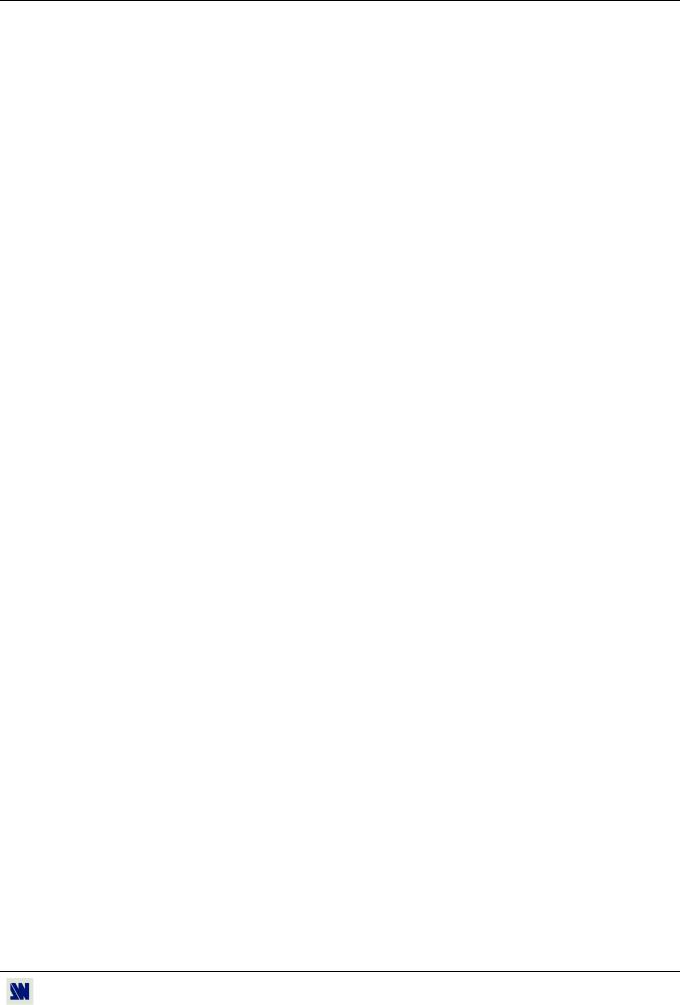
OCTO² / QFX402
SICHERHEITSHINWEISE
Um den Betrieb dieses Geräts zu verstehen, raten wir Ihnen vor der Inbetriebnahme alle Sicherheitsund Betriebsanweisungen genau zu lesen. Diese Sicherheitsund Betriebsanweisungen für einen späteren Gebrauch sicher aufbewahren. Alle in den Unterlagen, an dem Gerät und hier angegebenen Sicherheitsanweisungen einhalten.
VORSICHT & WARNUNG
ACHTUNG: um jegliches Risiko eines Stromschlags oder Feuers zu vermeiden, das Gerät nicht Regen, Feuchtigkeit oder intensiven Wärmequellen aussetzen.
EINBAU : Eine ausreichende Luftzufuhr sicherstellen, um jegliche Überhitzung im Gerät zu vermeiden. Das Gerät nicht auf und in Nähe von Textiloberflächen, die Belüftungsöffnungen verschließen können, aufstellen. Das Gerät nicht in Nähe von Wärmequellen, wie z.B. Heizkörper oder Warmluftkappe, aufstellen und es nicht dem direkten Sonnenlicht, übermäßigem Staub, Vibrationen oder mechanischen Stößen aussetzen. Dies kann zu Betriebsstörungen und Unfällen führen.
STROMVERSORGUNG : Das Gerät nur mit der auf dem Gerät oder dem Netzteil angegebenen Netzspannung betreiben. Geräte mit geerdeter Hauptstromversorgung müssen an eine Stromquelle mit effizienter Erdung angeschlossen werden. Diese Erdung darf auf keinen Fall geändert, umgangen oder entfernt werden.
STROMKABEL : Für Geräte mit einem Hauptschalter (Ein/Aus) erfolgt die Stromversorgung und Unterbrechung mittels dieses Hauptschalters. Geräte ohne Hauptschalter werden durch das Einstecken oder Herausziehen des Steckers in den Wandanschluß einoder ausgeschaltet. Für beide Fälle gelten folgende Richtlinien :
-Den Stecker aus dem Wandanschluß herausziehen wenn Sie das Gerät mehrere Tage oder länger nicht benutzen.
-Das Kabel mittels dem Stecker herausziehen. Niemals am Stromkabel selbst ziehen.
-Die Steckdose muß sich in der Nähe des Geräts befinden und leicht zugänglich sein.
-Das Stromkabel nicht fallen lassen und keine schweren Gegenstände auf es stellen.
Wenn das Stromkabel beschädigt ist, das Gerät sofort abschalten. Es ist gefährlich das Gerät mit einem beschädigten Stromkabel zu betreiben; ein abgenutztes Kabel kann zu einem Feuer oder Stromschlag führen. Das Stromkabel regelmäßig untersuchen. Für den Ersatz, wenden Sie sich an Ihren Verkäufer oder Kundendienststelle.
ANSCHLÜSSE : Bei allen Einund Ausgängen (außer der Stromversorgung) handelt es sich, gemäß EN 60950, um SicherheitsKleinspannunganschlüsse.
REPARATUR UND WARTUNG : Der Benutzer darf keinesfalls versuchen das Gerät selbst zu reparieren, die Öffnung des Geräts durch Abnahme der Abdeckhaube oder jeglichen anderen Teils des Gehäuses sowie die Entfernung von außen sichtbaren Schrauben zu Stromschlägen oder anderen Gefahren für den Benutzer führen kann. Wenden Sie sich an Ihren Verkäufer, Ihre Kundendienststelle oder an qualifizierte Fachkräfte.
ÖFFNUNGEN UND MUNDUNGEN : Die Geräte können über Öffnungen verfügen (Belüftung, Schlitze, usw.). Niemals Gegenstände in die Öffnungen einführen oder die Öffnungen verschließen. Wenn eine Flüssigkeit oder ein Gegenstand in das Gerät gelangt, den Stecker herausziehen und es vor einer neuen Inbetriebnahme von qualifiziertem Fachpersonal überprüfen lassen.
INSTRUCCIONES DE SEGURIDAD
Para comprender mejor el funcionamiento de este aparato, le recomendamos que lea cuidadosamente todas las consignas de seguridad y de funcionamiento del aparato antes de usarlo. Conserve las instrucciones de seguridad y de funcionamiento para que pueda consultarlas posteriormente. Respete todas las consignas indicadas en la documentación, relacionadas con el producto y este documento.
PRECAUCIONES Y OBSERVACIONES
CUIDADO : Para prevenir cualquier riesgo de choque eléctrico y de incendio, no exponga este aparato a la lluvia, a la humedad ni a fuentes de calorintensas.
INSTALACIÓN : Cerciórese de que haya una circulación de aire suficiente para evitar cualquier sobrecalentamiento al interior del aparato. No coloque el aparato cerca ni sobre una superficie textil que pudiera obstruir los orificios de ventilación. No instale el aparato cerca de fuentes de calor como radiador o boca de aire caliente, ni en un lugar expuesto a los rayos solares directos o al polvo excesivo, a las vibraciones o a los choques mecánicos. Esto podría provocar su mal funcionamiento o un accidente.
ALIMENTACIÓN : Ponga a funcionar el aparato únicamente con la fuente de alimentación que se indica en el aparato o en su bloque de alimentación. Los aparatos equipados con una alimentación principal con hilo de tierra deben estar conectados obligatoriamente a una fuente equipada con una puesta a tierra eficaz. Por ningún motivo este enlace de tierra deberá ser modificado, cambiado o suprimido.
CABLE DE ALIMENTACIÓN : Para los aparatos equipados con un interruptor general (Marcha I / Paro O), la puesta bajo tensión y la puesta fuera de tensión se hace accionando este interruptor general.. En los aparatos que no tienen interruptor general, la puesta bajo tensión y la puesta fuera de tensión se hace directamente conectando y desconectando el enchufe mural.
En ambos casos, se deberá respetar las siguientes consignas:
-Desconectar el aparato del enchufe mural si no piensa utilizarlo durante varios días.
-Para desconectar el cable, tire de la clavija. No tire nunca del cable propiamente dicho.
-El enchufe de alimentación debe estar cerca del aparato y ser de fácil acceso.
-No deje caer el cable de alimentación ni coloque objetos pesados encima de él.
Si el cable de alimentación sufriera algún daño, ponga el aparato inmediatamente fuera de tensión. Es peligroso hacer funcionar este aparato con un cable averiado, ya que un cable dañado puede provocar un incendio o un choque eléctrico. Verifique el estado del cable de alimentación de vez en cuando. Póngase en contacto con su distribuidor o con el servicio de posventa si necesita cambiarlo.
CONEXIONES : Todas las entradas y salidas (excepto la entrada del sector) son de tipo TBTS (Muy Baja Tensión de Seguridad) definidas según EN 60950.
REPARACIÓN Y MANTENIMIENTO : Por ningún motivo, el usuario deberá tratar de efectuar operaciones de reparación, ya que si abre los aparatos retirando el capó o cualquier otra pieza que forma parte de las cajas o si destornilla los tornillos aparentes exteriores, existe el riesgo de producirse una explosión, choques eléctricos o cualquier otro incidente. Contacte el servicio de posventa, a su distribuidor o dirigirse con personal cualificado únicamente.
ABERTURAS Y ORIFICIOS : Los aparatos pueden contener aberturas (aireación, ranuras, etc.). No introduzca allí ningún objeto ni obstruya nunca estas aberturas. Si un líquido o un objeto penetra al interior del aparato, desconéctelo y hágalo revisar por personal cualificado antes de ponerlo nuevamente en servicio.
PAGE 5
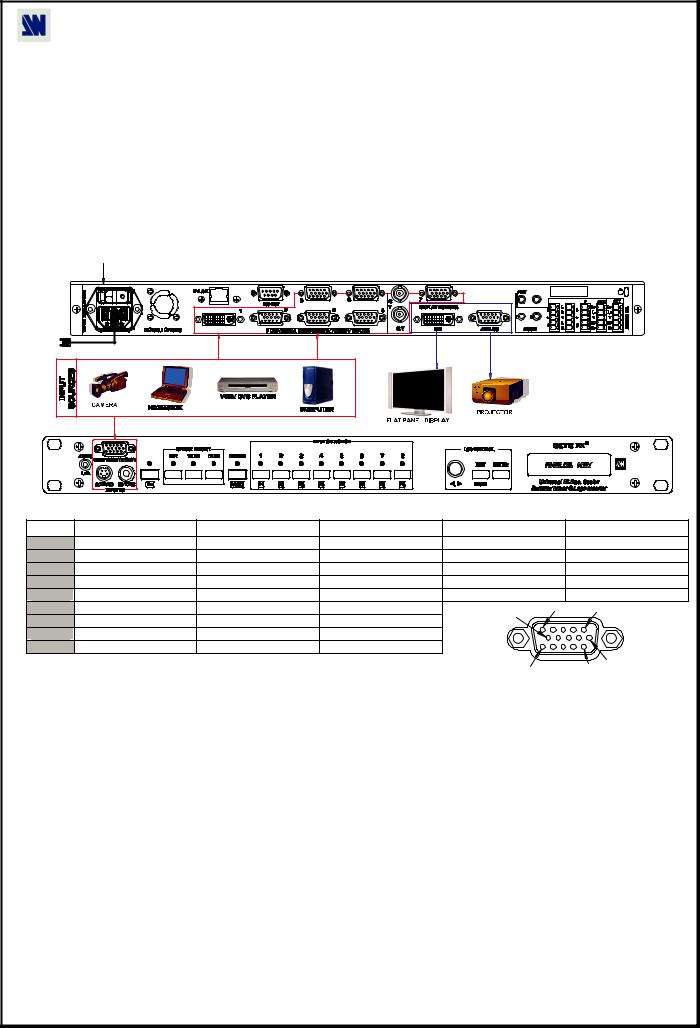
QUICK START GUIDE - OCTO2 |
|
ANALOG WAY |
EDITION : 11/06 |
CONNECTIONS: |
|
NOTE: Turn OFF all of your equipment before connecting. |
|
c Connect the AC power supply cord to the OFX803 / OFD803 / OCP803 and to an AC power outlet. |
|
dConnect your computer & video sources to the 8 universal inputs of the OFX803 / OFD803 / OCP803.
•If you need to connect a digital computer source, use the input #1 (DVI-I IN connector).
•Connect your others sources to the unused inputs.
IMPORTANT:Connect only one source by input.
e Connect your display device (projector, plasma screen...) to the HD15 or DVI connectors.
fTurn ON the OFX803 / OFD803 / OCP803 (rear panel switch). Then turn ON all your input sources and then your display device.
•Connection diagram:
4
1 |
2 |
2 |
3 |
3 |
2
|
|
|
|
|
|
ANALOG WAY |
• HD15 connector pin assignment (inputs #2 to #7 - input #1 with a DVI/HD15 adaptor): |
|
|
||||
SIGNAL |
COMPUTER (analog) |
RGB/S VIDEO |
YUV & HDTV (analog) |
S.VIDEO (Y/C) |
|
COMPOSITE VIDEO |
PIN 1 |
RED. |
RED. |
Cr / Pr. |
C (chrominance). |
|
|
PIN 2 |
GREEN. |
GREEN. |
Y. |
Y (luminance). |
|
VIDEO (NTSC, PAL...) |
PIN 3 |
BLUE. |
BLUE. |
Cb / Pb. |
|
|
|
PIN 6 |
RED return. |
RED return. |
Cr / Pr return. |
C return. |
|
|
PIN 7 |
GREEN return. |
GREEN return. |
Y return. |
Y return. |
|
return. |
PIN 8 |
BLUE return. |
BLUE return. |
Cb / Pb return. |
10 |
5 |
1 |
PIN 10 |
GND. |
GND. |
|
|
|
|
|
|
|
|
|||
PIN 13 |
H sync or C sync (S). |
C sync (S). |
|
|
|
|
PIN 14 |
V sync. |
|
|
|
|
6 |
|
|
|
|
15 |
|
|
SETTINGS: |
|
|
|
|
11 |
|
|
|
|
|
|
||
|
|
|
|
|
|
|
cWe recommend resetting the OFX803 / OFD803 / OCP803 device to all of its default values, with the front panel LCD menu (CONTROL > default value > yes) before proceeding.
d Select the fast or seamless switching mode with the LCD menu (SWITCHING > fast switching or seamless).
eSelect the Auto settings function with the LCD menu (INPUT > Auto settings). This function will detect automatically the source type connected to the inputs of the device. Sometimes, the auto setting may not detect the source type: in this case select manually the source type with the LCD menu (INPUT > Input type).
fIf you have selected the fast switching mode: select one of the output formats with the LCD menu (OUTPUT > output format). Then select the output rate with the LCD menu (OUTPUT > output rate).
gDisplay device adjustment:
•IN SEAMLESS MODE: Select the reference computer source. The reference computer image is displayed onto the output. Adjust directly the display device itself, using its position and size controls, to fill the computer image in full screen.
•IN FAST SWITCHING MODE: Display the centering pattern with the LCD menu (OUTPUT > test pattern > centering). Display a black output. Adjust directly the display device itself, using its position and size controls, to fill the centering pattern in full screen.
h For each input source connected to the device, make the following adjustments:
-Select the source you want to adjust (with the front panel "INPUT SELECTION" buttons). -Select the aspect ratio of your input source with the LCD menu (IMAGE > aspect ratio).
-Use the Centering function (IMAGE > centering) to automatically position the image in the Centering pattern. -As required, make the others adjustments, available in the LCD IMAGE menu (color, brightness…).

QUICK START GUIDE - QUATTRO FX |
|
ANALOG WAY |
EDITION : 11/06 |
CONNECTIONS: |
|
NOTE: Turn OFF all of your equipment before connecting. |
|
c Connect the AC power supply cord to the QFX402 and to an AC power outlet. |
|
dConnect your computer & video sources to the 4 universal inputs of the QFX402.
•If you need to connect a digital computer source, use the input #1 (DVI-I IN connector).
•Connect your others sources to the unused inputs.
IMPORTANT:Connect only one source by input.
e Connect your display device (projector, plasma screen...) to the HD15 or DVI connectors.
fTurn ON the QFX402 (rear panel switch). Then turn ON all your input sources and then your display device.
•Connection diagram:
4
1 |
2 |
2 |
3 |
3 |
|
|
|
|
|
|
ANALOG WAY |
• HD15 connector pin assignment (inputs #2 to #4 - input #1 with a DVI/HD15 adaptor): |
|
|
||||
SIGNAL |
COMPUTER (analog) |
RGB/S VIDEO |
YUV & HDTV (analog) |
S.VIDEO (Y/C) |
|
COMPOSITE VIDEO |
PIN 1 |
RED. |
RED. |
Cr / Pr. |
C (chrominance). |
|
|
PIN 2 |
GREEN. |
GREEN. |
Y. |
Y (luminance). |
|
VIDEO (NTSC, PAL...) |
PIN 3 |
BLUE. |
BLUE. |
Cb / Pb. |
|
|
|
PIN 6 |
RED return. |
RED return. |
Cr / Pr return. |
C return. |
|
|
PIN 7 |
GREEN return. |
GREEN return. |
Y return. |
Y return. |
|
return. |
PIN 8 |
BLUE return. |
BLUE return. |
Cb / Pb return. |
10 |
5 |
1 |
PIN 10 |
GND. |
GND. |
|
|
|
|
|
|
|
|
|||
PIN 13 |
H sync or C sync (S). |
C sync (S). |
|
|
|
|
PIN 14 |
V sync. |
|
|
|
|
6 |
|
|
|
|
15 |
|
|
SETTINGS: |
|
|
|
|
11 |
|
|
|
|
|
|
||
|
|
|
|
|
|
|
cWe recommend resetting the QFX402 device to all of its default values, with the front panel LCD menu (CONTROL > default value > yes) before proceeding.
d Select the fast or seamless switching mode with the LCD menu (SWITCHING > fast switching or seamless).
eSelect the Auto settings function with the LCD menu (INPUT > Auto settings). This function will detect automatically the source type connected to the inputs of the device. Sometimes, the auto setting may not detect the source type: in this case select manually the source type with the LCD menu (INPUT > Input type).
fIf you have selected the fast switching mode: select one of the output formats with the LCD menu (OUTPUT > output format). Then select the output rate with the LCD menu (OUTPUT > output rate).
gDisplay device adjustment:
•IN SEAMLESS MODE: Select the reference computer source. The reference computer image is displayed onto the output. Adjust directly the display device itself, using its position and size controls, to fill the computer image in full screen.
•IN FAST SWITCHING MODE: Display the centering pattern with the LCD menu (OUTPUT > test pattern > centering). Display a black output. Adjust directly the display device itself, using its position and size controls, to fill the centering pattern in full screen.
h For each input source connected to the device, make the following adjustments:
-Select the source you want to adjust (with the front panel "INPUT SELECTION" buttons). -Select the aspect ratio of your input source with the LCD menu (IMAGE > aspect ratio).
-Use the Centering function (IMAGE > centering) to automatically position the image in the Centering pattern. -As required, make the others adjustments, available in the LCD IMAGE menu (color, brightness…).
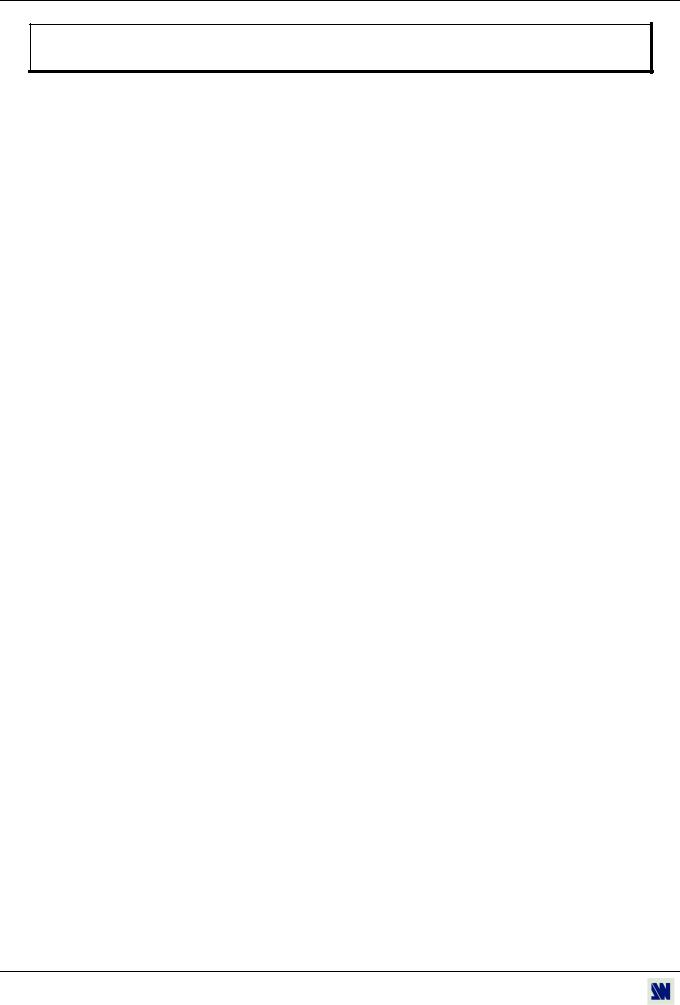
OCTO² / QFX402
OCTO-FX² / OCTO-FADE² / OCTO-PLUS² / QUATTRO FX
Chapter 1 : INTRODUCTION
1-1. ACCESSORIES SUPPLIED
•1 OCTO-FX² (OFX803) or 1 OCTO-FADE² (OFD803) or 1 OCTO-PLUS² (OCP803) or 1 QUATTRO FX (QFX402).
•1 AC Power supply cord.
•1 HD15 male / 5xBNC female cable adaptor.
•1 HD15 female / DVI-I male adaptor.
•1 Set of 5 MCO (5-pin) female connectors (OFX803, OFD803 & OCP803).
•1 Set of 3 MCO (5-pin) female connectors (QFX402).
•1 CD-ROM (Remote Control Software).
•1 User’s Manual.
1-2. OCTO² GENERAL INFORMATION
OCTO² by Analog Way is High Resolution Digital and Analog Computer & Video Up/Down Scaler Switcher.
It features many other effects: fading* & titling*, Hi-Res. logo insertion and frame store. It is fitted with 8 Universal A/V inputs including one DVI, and 3 outputs: 2 Analog and 1 DVI. It performs an ultra fast and smooth transition between any Video or Computer sources. It also allows a true seamless switching between one computer Input (direct) and any other Video or Computer Input.
Title Effect*: The device can mix a Computer source with a Title with any Video or Computer source. The title remains on the screen during the transition. The device also features a shadow title effect with settable vertical size and position that enhances the readability of the titling text over very bright images.
Fade Effect*: The device features cross-fade effects between Computer and Video (TV/HDTV) or Computer sources, with adjustment of the cross-fading duration.
Logos and Frames**: The device can store in its non volatile memory 8 Still or 1 Animated Logos and 4 Full Frame Images in true Hi-Res. 16 million colors. Recording is done either by direct acquisition from Input source or from Computer download of image files. Up to 2 Logos can be assigned to each input to be displayed at any position on the output screen.
Logos can have any shape due to the keying capability, and transparency is user adjusted. Full Frames can be used as welcome or transition image.
The device is a High Performance State of the Art Up/Down Video and Computer Scaler. Ready to fit the native resolution of the latest HD display devices, it provides a high quality image thanks to its high quality digital decoder, improved 3:2 and 2:2 pull down circuitry, auto-adaptative pixel by pixel 3D motion compensation, time base corrector, frame rate converter & follower.
Easy to use, the device offers Auto Setup function, Auto Clock and Phase for Computers. Each input image control - brightness, contrast, color, hue, processing, aspect ratio, zoom, etc … - can be individually set and stored in nonvolatile memories. Each of the 8 Inputs is fitted with a stereo audio line. The audio can either follow or break away from the Video image. One additional audio stereo input is provided to be mixed with the Video input audio line. The device is fitted with a Dual RS232 Com port for Integral remote control and automatic control of other devices in the installation. Full Firmware upgrade maintains high value to your equipment through permanent additional possibility in the apparatus life time. Upgrades are available on Analog Way web site. An optional TCP/IP connection allows far away remote and/or upgrade.
This ultra compact and user friendly device is especially dedicated to high resolution A/V presentation displays, conference and boardrooms, and events.
* OCTO-FX² & OCTO-FADE². |
** OCTO-FX² only. |
PAGE 8

OCTO² / QFX402 Chapter 1 : INTRODUCTION (continued)
1-3. QUATTRO FX GENERAL INFORMATION
QUATTRO FX by Analog Way is High Resolution Digital and Analog Computer & Video Up/Down Scaler Switcher. It features many other effects: fading & titling, Hi-Res. logo insertion and frame store. It is fitted with 4 Universal A/V inputs including one DVI, and 2 outputs: 1 Analog and 1 DVI. It performs an ultra fast and smooth transition between any Video or Computer sources. It also allows a true seamless switching between one computer Input (direct) and any other Video or Computer Input.
Title Effect: The device can mix a Computer source with a Title with any Video or Computer source. The title remains on the screen during the transition. The device also features a shadow title effect with settable vertical size and position that enhances the readability of the titling text over very bright images.
Fade Effect: The device features cross-fade effects between Computer and Video (TV/HDTV) or Computer sources, with adjustment of the cross-fading duration.
Logos and Frames: The device can store in its non volatile memory 8 Still or 1 Animated Logos and 4 Full Frame Images in true Hi-Res. 16 million colors. Recording is done either by direct acquisition from Input source or from Computer download of image files. Up to 2 Logos can be assigned to each input to be displayed at any position on the output screen.
Logos can have any shape due to the keying capability, and transparency is user adjusted. Full Frames can be used as welcome or transition image.
The device is a High Performance State of the Art Up/Down Video and Computer Scaler. Ready to fit the native resolution of the latest HD display devices, it provides a high quality image thanks to its high quality digital decoder, improved 3:2 and 2:2 pull down circuitry, auto-adaptative pixel by pixel 3D motion compensation, time base corrector, frame rate converter & follower.
Easy to use, the device offers Auto Setup function, Auto Clock and Phase for Computers. Each input image control - brightness, contrast, color, hue, processing, aspect ratio, zoom, etc … - can be individually set and stored in nonvolatile memories. Each of the 4 Inputs is fitted with a stereo audio line. The audio can either follow or break away from the Video image. The device is fitted with a Dual RS232 Com port for Integral remote control and automatic control of other devices in the installation. Full Firmware upgrade maintains high value to your equipment through permanent additional possibility in the apparatus life time. Upgrades are available on Analog Way web site. An optional TCP/IP connection allows far away remote and/or upgrade.
This ultra compact and user friendly device is especially dedicated to high resolution A/V presentation displays, conference and boardrooms, and events.
1-4. DEVICES & OPTIONS REFERENCES
|
REFERENCE |
|
DESIGNATION |
|
OFX803 |
|
OCTO-FX². |
|
OFD803 |
|
OCTO-FADE². |
|
OCP803 |
|
OCTO-PLUS². |
|
QFX402 |
|
QUATTRO FX. |
|
|
|
LAN communication port (optional). |
|
OPT-LAN |
|
|
1-5. INSTALLATION |
|
||
|
IMPORTANT: |
Please read all the safety instructions (pages 3 to 5) before starting. |
|
•Table Top Mounting: The device can be used directly on a table: the unit is equipped with 4 plastic feet.
•Rack Mounting: The device is compatible with a 19" enclosure. To install the device into a 19” rack: Attach the
device to the rack by using 4 screws in the front panel holes (screws are not included).
IMPORTANT: |
• The openings in the rear and side panels are for cooling. Do not cover these openings. |
|
• Be sure that no weight is added to the device in excess of 2 kg (4.4 lbs.). |
|
• The maximum ambient operating temperature must not exceed 40°C (104°F). |
|
• The rack and all mounted equipment in it must be reliably grounded to national and |
|
local electrical codes. |
PAGE 9
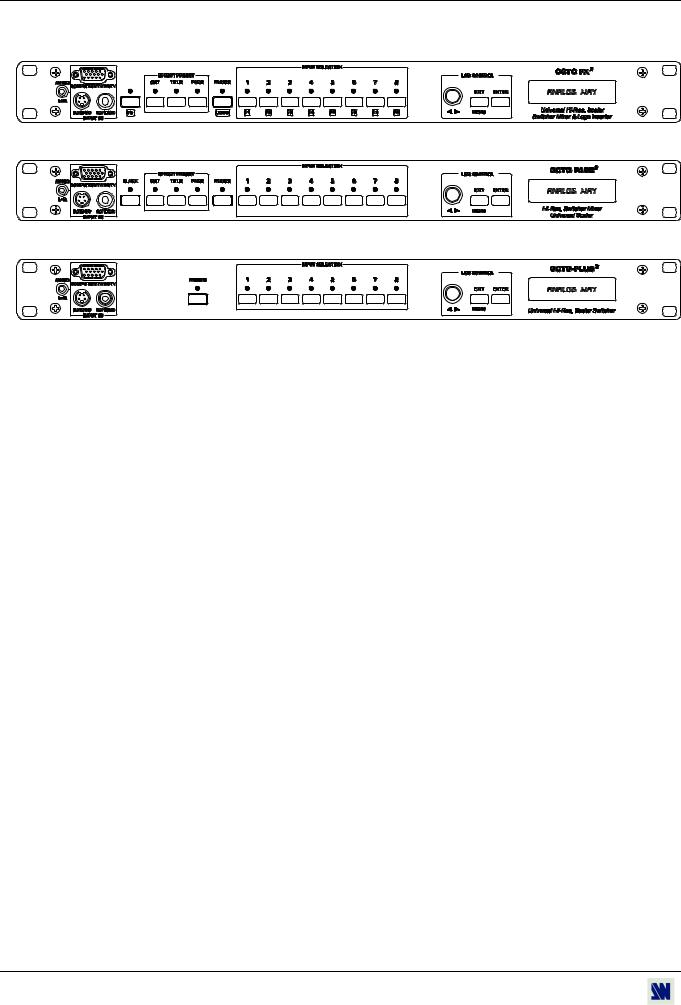
Chapter 1 : INTRODUCTION (continued) OCTO² / QFX402
1-6. OCTO² FRONT PANEL DESCRIPTION
• OCTO-FX² (OFX803)
 ANALOG WAY
ANALOG WAY
• OCTO-FADE² (OFD803)
 ANALOG WAY
ANALOG WAY
• OCTO-PLUS² (OCP803)
 ANALOG WAY
ANALOG WAY
INPUT #8: |
Universal (computer and video) input. This input accepts the following sources: |
AUDIO L+R: |
Audio stereo source on jack 3.5 female connector. |
COMPUTER/TV/HDTV: Computer (RGBHV, RGBS or RGsB) or video (SDTV or HDTV) source on a HD15 female connector.
S.VIDEO: |
S.VIDEO (Y/C) source on 4-pin mini DIN 4 female connector. |
C.VIDEO: |
Composite Video (PAL, NTSC...) source on a RCA female connector. |
Fn (OFX803 only): |
Secondary function selection button. |
BLACK (OFD803 only): |
Allows to display a black screen. |
EFFECT PRESET : |
Selection of the CUT, FADE & TITLE effects. |
(OFX803 & OFD803) |
|
FREEZE : |
Freeze the output (the blinking LED indicates the FREEZE is active). |
LOGO (OFX803 only): |
Allows to display logo onto the output. |
|
NOTE: Logo display can be used only when Fn is activate. |
INPUT SELECTION: |
• Selection of the 8 input sources: 1 to 8. |
|
• Selection of the 4 frames: F1 to F4 (OFX803 only). |
|
NOTE: -Frame selection can be used only when Fn is activate (LED blinking quickly). |
|
-The source/frame displayed onto the output is indicate by a turn ON LED. |
|
• A long push (1 second) on the selected input button allows to active the BLACK |
|
function. A black screen is displayed onto the corresponding output. A short push on the |
|
same button allows to inactive this function. |
CONTROL |
Allows to scroll thru the different menus (in Control mode). |
|
|
EXIT - MENU: |
Switches between Status and Control mode. |
ENTER: |
Validates a selected item. |
PAGE 10
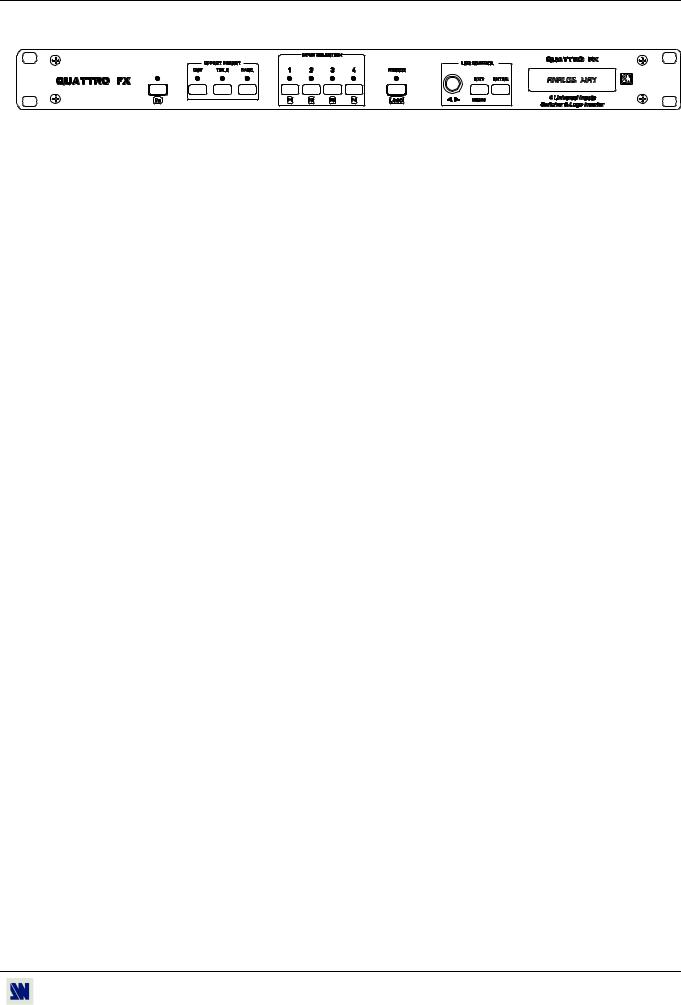
OCTO² / QFX402 |
Chapter 1 : INTRODUCTION (continued) |
1-7. QUATTRO-FX FRONT PANEL DESCRIPTION |
|
|
ANALOG WAY |
Fn: |
Secondary function selection button. |
EFFECT PRESET : |
Selection of the CUT, FADE & TITLE effects. |
INPUT SELECTION: |
• Selection of the 4 input sources: 1 to 4. |
|
• Selection of the 4 frames: F1 to F4. |
|
NOTE: -Frame selection can be used only when Fn is activate (LED blinking quickly). |
|
-The source/frame displayed onto the output is indicate by a turn ON LED. |
|
• A long push (1 second) on the selected input button allows to active the BLACK |
|
function. A black screen is displayed onto the corresponding output. A short push on the |
|
same button allows to inactive this function. |
FREEZE : |
Freeze the output (the blinking LED indicates the FREEZE is active). |
LOGO: |
Allows to display logo onto the output. |
|
NOTE: Logo display can be used only when Fn is activate. |
CONTROL |
Allows to scroll thru the different menus (in Control mode). |
|
|
EXIT - MENU: |
Switches between Status and Control mode. |
ENTER: |
Validates a selected item. |
PAGE 11
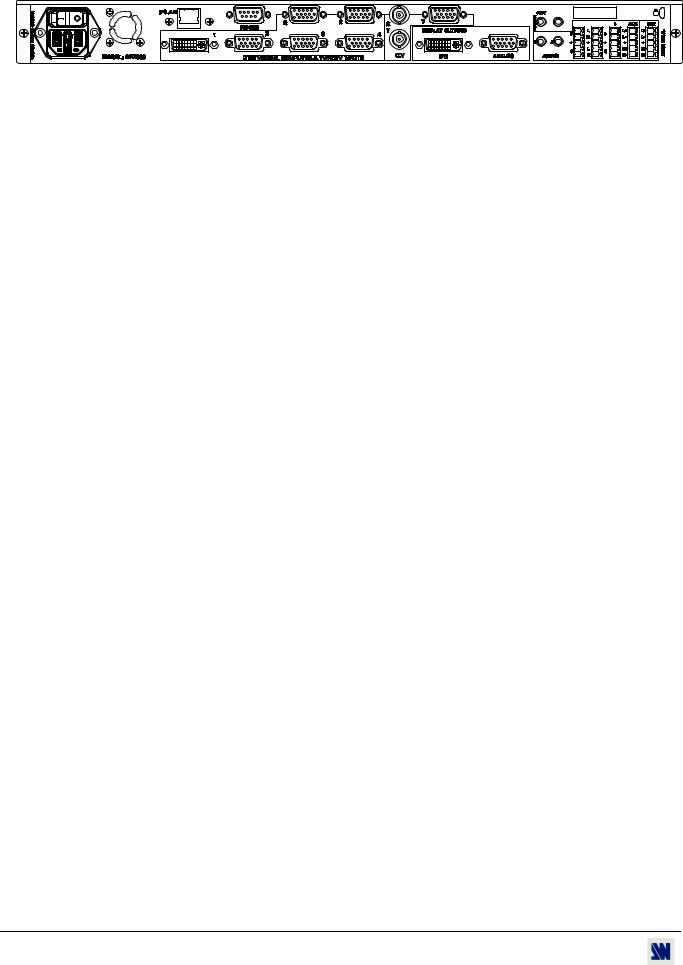
Chapter 1 : INTRODUCTION (continued) |
OCTO² / QFX402 |
1-8. OCTO² REAR PANEL DESCRIPTION
|
|
|
|
|
|
|
|
|
|
|
|
|
|
|
|
|
|
|
|
|
|
|
|
|
|
|
|
|
|
|
|
|
|
|
|
|
|
|
|
|
|
|
|
|
|
|
|
|
|
|
|
|
|
|
|
|
|
|
|
|
|
|
|
|
|
|
|
|
|
|
|
|
|
|
|
|
|
100-250 VAC, 1A, 50-60 Hz: |
AC power inlet. |
||||||||||||||||||||||||
O / I: |
AC power switch (O = OFF, I = ON). |
||||||||||||||||||||||||
IP/LAN: |
LAN communication port on a RJ45 connector (optional). |
||||||||||||||||||||||||
RS-232: |
RS-232 communication port on a DB9 female connector. |
||||||||||||||||||||||||
7 UNIVERSAL COMPUTER & TV/HDTV INPUTS: |
|||||||||||||||||||||||||
1: |
|
|
|
|
|
|
|
|
|
Universal (computer and video) input on a DVI-I female connector. |
|||||||||||||||
|
|
|
|
|
|
|
|
|
|
|
NOTE: This input accept analog & digital Computer source. |
||||||||||||||
|
2 to 6: |
Universal (computer and video) inputs on a HD15 female connector. |
|||||||||||||||||||||||
7: |
|
|
|
|
|
|
|
|
|
Universal (computer and video) input on HD15 and 2xBNC female connectors. |
|||||||||||||||
NOTE: All the universal inputs accept the following video source: Composite Video, S-Video, SD-YUV, RGBHV, RGBS, RGsB &HD-YUV (HDTV)
DISPLAY OUTPUTS: |
|
DVI: |
Digital & analog output on a DVI-I female connector. |
ANALOG: |
Analog output on a HD15 female connector. |
AUDIO: |
|
1 & 2: |
Unbalanced stereo audio input #1 & #2 on jack 3.5 female connectors. |
3 to 6: |
Unbalanced stereo audio input #3 to #6 on MCO male connectors. |
7: |
Balanced stereo audio input #7 on a MCO male connector. |
AUX: |
Balanced stereo auxiliary audio input on a MCO male connector. |
OUT: |
Stereo audio output (balanced & unbalanced) on a MCO male connector. |
Trigger +12 V: |
A room (+ 12 Vdc trigger) command (3.5 mm jack female), allows to control external |
|
functions such as up/down screen, lighting... |
PAGE 12
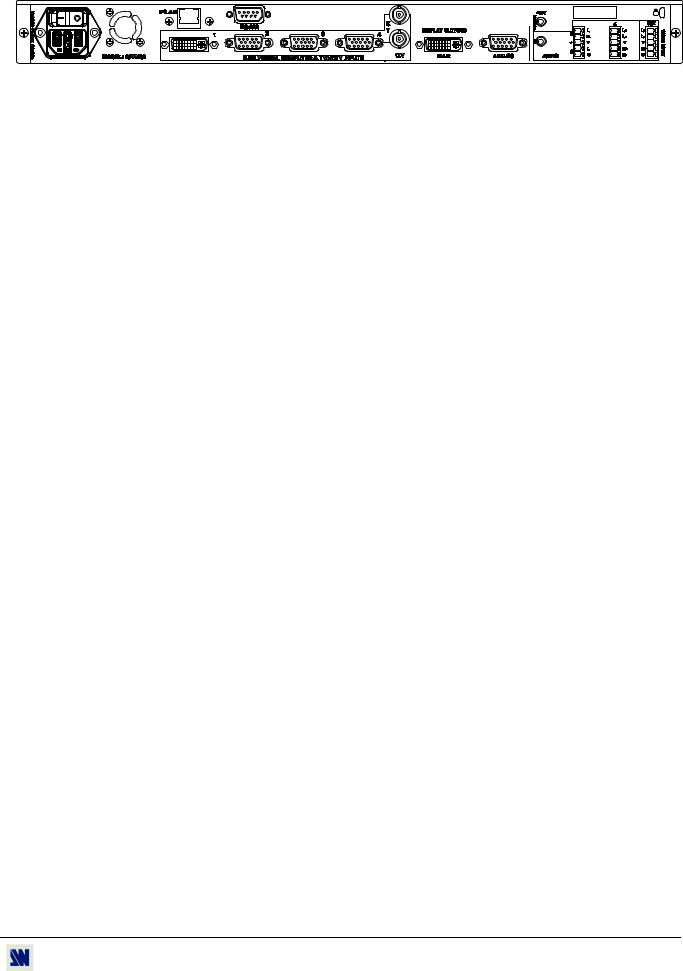
OCTO² / QFX402 |
Chapter 1 : INTRODUCTION (continued) |
1-9. QUATTRO FX REAR PANEL DESCRIPTION
|
|
|
|
|
|
|
|
|
|
|
|
|
|
|
|
|
|
|
|
|
|
|
|
|
|
|
|
|
|
|
|
|
|
|
|
|
|
|
|
|
|
|
|
|
|
|
|
|
|
|
|
|
|
|
|
|
|
|
|
|
|
|
|
|
|
|
|
|
|
|
|
|
|
|
|
|
|
|
|
|
|
|
|
|
|
|
|
|
|
|
|
|
|
|
|
|
|
|
|
|
|
|
|
|
|
|
|
|
|
|
|
100-250 VAC, 1A, 50-60 Hz: |
AC power inlet. |
||||||||||||||||||||||||||
O / I: |
AC power switch (O = OFF, I = ON). |
||||||||||||||||||||||||||
IP/LAN: |
LAN communication port on a RJ45 connector (optional). |
||||||||||||||||||||||||||
RS-232: |
RS-232 communication port on a DB9 female connector. |
||||||||||||||||||||||||||
4 UNIVERSAL COMPUTER & TV/HDTV INPUTS: |
|||||||||||||||||||||||||||
1: |
|
|
|
|
|
|
|
|
|
Universal (computer and video) input on a DVI-I female connector. |
|||||||||||||||||
|
|
|
|
|
|
|
|
|
|
|
NOTE: This input accept analog & digital Computer source. |
||||||||||||||||
|
2 to 3: |
Universal (computer and video) inputs on a HD15 female connector. |
|||||||||||||||||||||||||
4: |
|
|
|
|
|
|
|
|
|
Universal (computer and video) input on HD15 and 2xBNC female connectors. |
|||||||||||||||||
NOTE: All the universal inputs accept the following video source: Composite Video, S-Video, SD-YUV, RGBHV, RGBS, RGsB & HD-YUV (HDTV)
DISPLAY OUTPUTS: |
|
DVI-D: |
Digital output on a DVI-I female connector. |
ANALOG: |
Analog output on a HD15 female connector. |
AUDIO: |
|
1: |
Unbalanced stereo audio input #1 on jack 3.5 female connectors. |
2 & 3: |
Unbalanced stereo audio input #2 & #3 on MCO male connectors. |
4: |
Balanced stereo audio input #4 on a MCO male connector. |
OUT: |
Stereo audio output (balanced & unbalanced) on a MCO male connector. |
Trigger +12 V: |
A room (+ 12 Vdc trigger) command (3.5 mm jack female), allows to control external |
|
functions such as up/down screen, lighting... |
PAGE 13
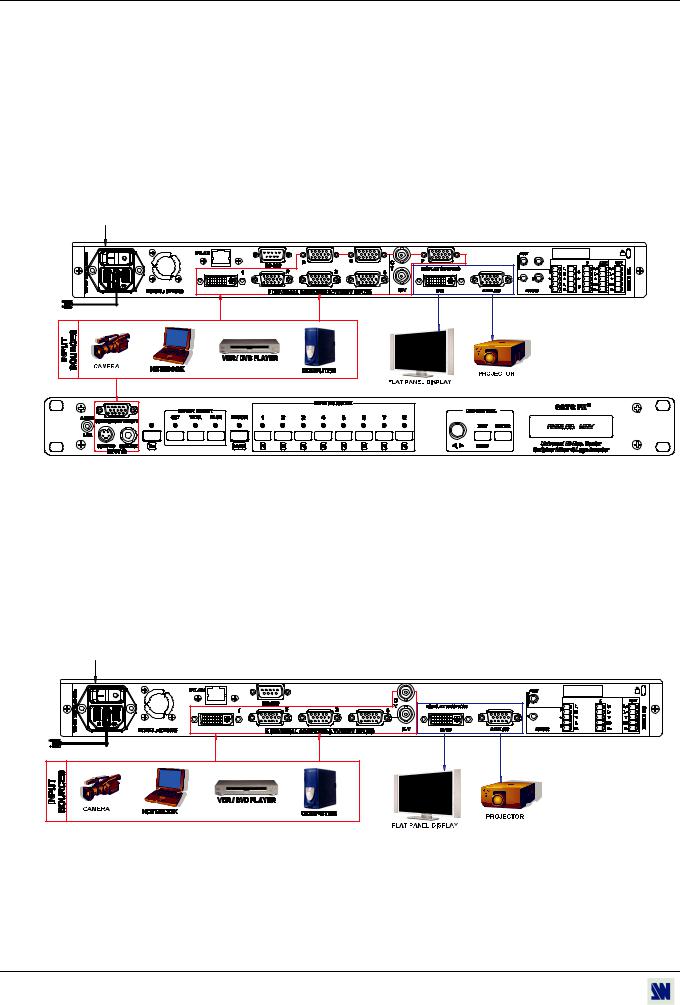
OCTO² / QFX402
Chapter 2 : STARTING
2-1. OCTO² CONNECTIONS
NOTE: Turn OFF all of your equipment before connecting.
c Connect the AC power supply cord to the device and to an AC power outlet.
dConnect your computer & video sources to the 8 universal inputs of the device.
•If you need to connect a digital computer source, use the input #1 (DVI-I IN connector).
•Connect your others sources to the unused inputs. See following sections to have a complete description.
IMPORTANT: Connect only one source by input.
e Connect your display device (projector, plasma screen...) to the HD15 or DVI connectors.
f Turn ON the device (rear panel switch). Then turn ON all your input sources and then your display device.
• Connection diagram:
4
1 |
2 |
2 |
3 |
3 |
2
 ANALOG WAY
ANALOG WAY
2-2. QUATTRO FX CONNECTIONS
NOTE: Turn OFF all of your equipment before connecting.
c Connect the AC power supply cord to the device and to an AC power outlet.
dConnect your computer & video sources to the 4 universal inputs of the device.
•If you need to connect a digital computer source, use the input #1 (DVI-I IN connector).
•Connect your others sources to the unused inputs. See following sections to have a complete description.
IMPORTANT: Connect only one source by input.
e Connect your display device (projector, plasma screen...) to the HD15 or DVI connectors.
f Turn ON the device (rear panel switch). Then turn ON all your input sources and then your display device.
• Connection diagram:
4
1 |
2 |
2 |
3 |
3 |
PAGE 14
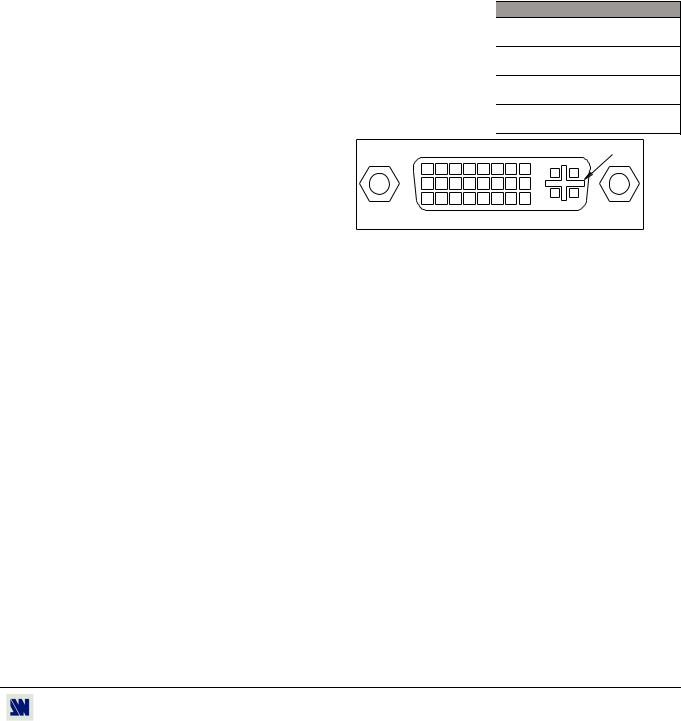
OCTO² / QFX402 |
Chapter 2 : STARTING (continued) |
2-3. INPUT #1 DESCRIPTION
cCONNECTION:
You can connect to this input one of the following source:
•A composite video source.
•A S.VIDEO source.
•A Component video source (YUV).
•A HD-YUV source.
•A RGBS video source.
•An analog (RGBHV, RGsB, RGBS) computer source.
NOTE: You can use the DVI / HD15 adaptor provided with the device to connect analog sources on the DVI-I (IN) connector.
• A digital computer source.
dDVI-I PIN ASSIGNMENT:
The DVI-I female connector of the device can be used with digital signals as well as analog signals. The table hereafter explain the pin assignment of this connectors.
Pin |
Function |
|
Pin |
Function |
|
Pin |
Function |
|
|
||
1 |
TMDS Data 2- |
|
9 |
TMDS Data 1- |
|
17 |
TMDS Data 0- |
|
|||
2 |
TMDS Data 2+ |
|
10 |
TMDS Data 1+ |
|
18 |
TMDS Data 0+ |
|
|||
3 |
TMDS Data 2 Shield |
|
11 |
TMDS Data 1 Shield |
|
19 |
TMDS Data 0 Shield |
|
|||
4 |
Not used. |
|
12 |
Not used. |
|
20 |
Not used. |
|
|
||
5 |
Not used. |
|
13 |
Not used. |
|
21 |
Not used. |
|
|
||
6 |
DDC Clock |
|
14 |
+ 5V (Power) |
|
22 |
TMDS Clock Shield |
|
|||
7 |
DDC Data |
|
15 |
Ground for (+5V) |
|
23 |
TMDS Clock+ |
|
|||
8 |
Analog Vertical Sync. |
|
16 |
Hot plug detect. |
|
24 |
TMDS Clock- |
|
|||
C1 |
Analog Red video (or Cr / Pr or C) |
|
|
|
1 |
|
8 |
C1 |
C2 |
C5 |
|
C2 |
Analog Green Video (or Y or composite video) |
|
|
||||||||
|
|
|
|
|
|
|
|||||
C3 |
Analog Bleu Video (or Cb / Pb) |
|
|
|
9 |
|
16 |
|
|
|
|
C4 |
Analog Horizontal Sync (or composite sync) |
|
|
|
|
|
|||||
C5 |
Analog Common Ground Return |
|
|
|
|
|
|
|
|
|
|
DDC = Display Data Channel. |
|
|
|
17 |
|
24 |
C3 |
C4 |
|
||
TMDS = Transition Minimized Differential Signal. |
|
|
|
|
|
|
|||||
eAUDIO SOURCE:
You can also connect an AUDIO stereo source on jack 3.5 connectors.
PAGE 15
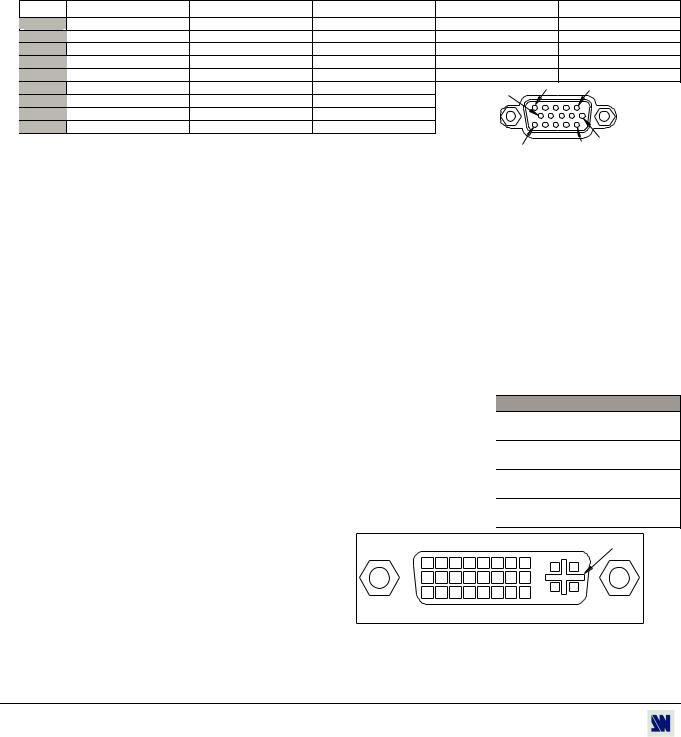
Chapter 2 : STARTING (continued) |
OCTO² / QFX402 |
2-4. INPUTS #2 to 8 DESCRIPTION
cCONNECTION:
You can connect to these inputs one of the following source:
• A composite video source.
NOTE: The input #7 can accept a composite video source on its BNC connector. The input #8 can accept a composite video source on its RCA connector.
• A S.VIDEO source.
NOTE: The input #7 can accept a S.VIDEO source on its BNC connectors. The input #8 can accept a S.VIDEO source on its 4-pin mini DIN connector.
•A Component video source.
•A HD-YUV source.
•A RGBS video source.
•An analog computer source (RGBHV, RGsB, RGBS).
d HD15 PIN ASSIGNMENT:
SIGNAL |
COMPUTER (analog) |
VIDEO RGB/S |
YUV & HD-YUV |
S.VIDEO (Y/C) |
|
COMPOSITE VIDEO |
PIN 1 |
RED. |
RED. |
Cr / Pr. |
C (chrominance). |
|
|
PIN 2 |
GREEN. |
GREEN. |
Y. |
Y (luminance). |
|
VIDEO (NTSC, PAL...) |
PIN 3 |
BLUE. |
BLUE. |
Cb / Pb. |
|
|
|
PIN 6 |
RED return. |
RED return. |
Cr / Pr return. |
C return. |
|
|
PIN 7 |
GREEN return. |
GREEN return. |
Y return. |
Y return. |
|
return. |
PIN 8 |
BLUE return. |
BLUE return. |
Cb / Pb return. |
10 |
5 |
1 |
PIN 10 |
GND. |
GND. |
|
|
|
|
|
|
|
|
|||
PIN 13 |
H sync or C sync (S). |
C sync (S). |
|
|
|
|
PIN 14 |
V sync. |
|
|
|
|
6 |
|
|
|
|
15 |
|
|
|
|
|
|
|
11 |
|
|
|
|
|
HD15 female connector of the device. |
||
eAUDIO SOURCE:
-You can connect an unbalanced stereo audio source on a jack 3.5 connector (input #2 & 8). -You can connect an unbalanced stereo audio source on a MCO connector (input #3 to 6).
-You can connect an unbalanced or balanced stereo audio source on a MCO connector (input #7).
2-5. OUTPUTS DESCRIPTION
cANALOG OUTPUT:
You can connect to this output an analog display device.
dDVI OUTPUT:
You can connect to this output an analog* or digital display device.
|
|
* OFX803, OFD803 & OCP803. |
|
|
|
|
|
|
|
|
|
|
||
|
e DVI-I PIN ASSIGNMENT (OFX803, OFD803, OCP803): |
|
|
|
Function |
|
|
|||||||
|
Pin |
|
Function |
|
Pin |
Function |
|
|
Pin |
|
|
|||
1 |
|
TMDS Data 2- |
|
9 |
TMDS Data 1- |
|
|
17 |
TMDS Data 0- |
|
||||
2 |
|
TMDS Data 2+ |
|
10 |
TMDS Data 1+ |
|
|
18 |
TMDS Data 0+ |
|
||||
3 |
|
TMDS Data 2 Shield |
|
11 |
TMDS Data 1 Shield |
|
|
19 |
TMDS Data 0 Shield |
|
||||
4 |
|
Not used. |
|
12 |
Not used. |
|
|
20 |
Not used. |
|
|
|||
5 |
|
Not used. |
|
13 |
Not used. |
|
|
21 |
Not used. |
|
|
|||
6 |
|
DDC Clock |
|
14 |
+ 5V (Power) |
|
|
22 |
TMDS Clock Shield |
|
||||
7 |
|
DDC Data |
|
15 |
Ground for (+5V) |
|
|
23 |
TMDS Clock+ |
|
||||
8 |
|
Analog Vertical Sync. |
|
16 |
Hot plug detect. |
|
|
24 |
TMDS Clock- |
|
||||
|
C1 |
|
Analog Red video (or Cr / Pr or C) |
|
|
|
1 |
|
|
8 |
C1 |
C2 |
C5 |
|
|
C2 |
|
Analog Green Video (or Y or composite video) |
|
|
|
||||||||
|
|
|
|
|
|
|
|
|
|
|||||
|
C3 |
|
Analog Bleu Video (or Cb / Pb) |
|
|
|
9 |
|
|
16 |
|
|
|
|
|
C4 |
|
Analog Horizontal Sync (or composite sync) |
|
|
|
|
|
|
|||||
|
C5 |
|
Analog Common Ground Return |
|
|
|
|
|
|
|
|
|
|
|
DDC = Display Data Channel. |
|
|
|
17 |
|
|
24 |
C3 |
C4 |
|
||||
TMDS = Transition Minimized Differential Signal. |
|
|
|
|
|
|
|
|||||||
PAGE 16
